
A Word on the Future of Cellular Orthopedics
Actually, that future started last week when we used a more aggressive PRP adjunct at the time of two Bone Marrow Concentrate/ Stem Cell interventions; one for an arthritic hip and the other, in an arthritic knee. More accurate and descriptive would be a Bone Marrow Concentrate/Adult Mesenchymal Stem Cell/ Hematopoietic Stem Cell/ Growth Factor Concentrate/Platelet Rich Plasma/Interleukin-1 Receptor Antagonist cellular orthopedic intervention to an arthritic joint but even I get confused, so I will stick to cellular orthopedics and Bone Marrow Concentrate.
It would seem from current Regenerative Medicine Science, that while concentrated and activated Platelet Rich Plasma alone has not been provided a predictable and reliable independent approach to arthritis, when aggressively used in conjunction with stem cell interventions, PRP significantly enhances the results in the short term. It will require another several years to determine if what we are seeing in the short term will continue to improve our outcomes in the long run. I am not waiting as concentrating and activating the platelets will cause no harm; and if there is the promise of long term benefits when used as an adjunct both at the time of the Bone Marrow collection, concentration and intervention as well as again in two to five days, there is no reason not to proceed.
What about the future? While we have been great advocates of counting cells at the time of the stem cell intervention, new tools are being introduced to allow us to better customize that which we inject after concentrating and processing of the bone marrow. We now will be able to get a more accurate count of that which is present in the concentrated and processed injectate prior to the intervention and add bone marrow or platelets if indicated.
Are Mesenchymal Stem cells really Stem Cells? Professor Arnold Caplan of Case Western Reserve is widely considered the father of mesenchymal stem cells. He now takes the view that MSCs aren’t stem cells and that he should have never given them that name. He also believes that the primary function of these cells is paracrine, so he calls them “medicinal signaling cells”. To save you the trouble, paracrine is defined as “a form of cell-cell communication in which a cell produces a signal to induce changes in nearby cells.” I am not negating the importance of mesenchymal stem cells, rather I want the reader to better understand the role of each component involved with regenerative medicine. It was Professor Caplan’s prodding that in part is responsible for my having entered the discipline of interventional orthopedics. Long ago, we became friends as team mates of the Roosevelt High School championship football team in Chicago; and our professional paths, while parallel, he in basic orthopedic research while I chose orthopedic surgery finally crossed again five years ago.
To learn more about the basic science behind Cellular Orthopedics or to find out about how you might postpone or avoid a Total Joint replacement for an arthritic joint, schedule a consultation (312) 475 1893
Tags: arthritis, athletes, bone marrow, Bone Marrow Concentrate, cellular orthopedics, Clinical Studies, Concentrated Stem Cell Plasma, Growth Factor Concentrate, Growth Factors, Hematopoietic Stem Cell, Hip Replacement, Interleukin-1 Receptor Antagonist, knee arthritis, Mesenchymal Stem Cell, Mitchell B. Sheinkop MD, Orthopedics, Osteoarthritis, paracrine, Platelet Rich Plasma, Professor Arnold Caplan, PRP, Regenerative Pain Center, stem cells
